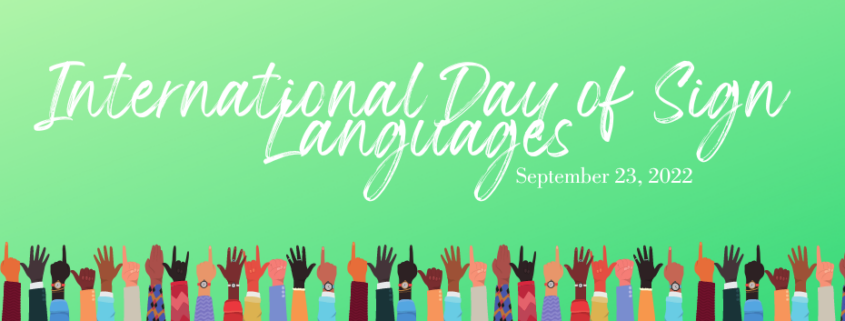International Day of Sign Languages
The International Day of Sign Languages is a unique opportunity to support and protect the linguistic identity and cultural diversity of the Deaf community and other sign language users. Since 2018, September 23rd has been declared as the International Day of Sign Languages, a carefully selected date commemorating the launch of the World Federation of the Deaf (WFD) in 1951 in Rome, Italy. WFD represents deaf associations from 133 countries, representing the rights of approximately 70 million deaf people worldwide, and whose main goal is to preserve sign languages and Deaf culture.
Sign language is a visual language expressed through physical movements, such as cues from the hands and facial expressions. Sign languages are fully fledged natural languages, structurally distinct from spoken languages. Over 300 unique sign languages exist and vary based on dialects, accents, and physical movements. While there is no universal sign language used worldwide, there are several internationally recognized signs used formally in meetings and informally when travelling or socializing.
Education
Despite the large population of deaf people across the globe, education and language access is a huge problem, especially in developing nations. According to the World Federation of the Deaf, an estimated 56 million Deaf people – approximately 80% of the 70 million deaf people in the world today – receive no education at all.
Considerable progress has been made, however, in providing educational resources related to American Sign Language (ASL). Over the past decades, almost 30 states and numerous universities and community colleges (e.g., Georgetown, Brown, the University of Washington, and Purdue) have passed relevant legislation to recognize American Sign Language as a foreign language. Now, ASL has become the third most studied foreign language, outnumbered only by Spanish and French (Modern Language Association’s 2016 study of U.S. colleges and universities).
With schools and universities in the United States recognizing ASL as a foreign language, and more students than ever undertaking ASL coursework, it is important to keep in mind ethnocentric assumptions that can be carried with interpreters abroad. Translators can make a difference by learning indigenous signs and
researching the meaning behind native-spoken language terms rather than inventing signs for objects, events, and places or spelling the English names for objects.
In addition, the onset of the COVID-19 pandemic in 2020 forced many schools to transition to e-learning – something that disproportionately challenges deaf and hard of hearing students. However, with video conferencing platforms like Zoom, deaf and hearing-impaired students were equipped with several resources that granted a smooth transition from an in-person to online education. For example, Zoom recently added closed captioning in real time to meetings and webinars, allowing hearing-impaired students to resume “face-to-face” interactions with their teachers and peers.
Celebrate & Make a Difference
The World Federation of the Deaf has a special way of celebrating the International Day of Sign Languages by dedicating the entire week to those in the Deaf community, with each day having a unique theme. The overall theme for 2022 is “Building Inclusive Communities for All.” One of the days is “Sign Languages for Education” – designed to encourage sign language education; another is “Intersectional Deaf Communities” – meant to promote the intersectional nature of Deaf communities.
Aside from learning ASL, there are several ways that the hearing community can make a difference. Not all deaf and hard-of-hearing people use ASL or interpreters, therefore, it is helpful to ask for a preferred form of communication, such as closed captioning or lipreading. Additionally, taking turns when speaking in groups, optimizing positioning, and using clear face masks to improve visibility of facial expressions and lip-reading cues are small changes that can make a significant difference.
By: Julie Johnson, Marketing & Communications Intern

